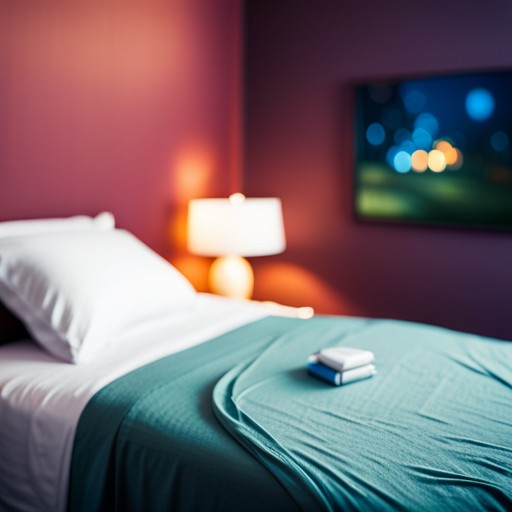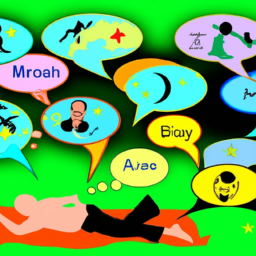Did you know that, on average, a person spends about six years of their life dreaming? That’s a whopping 2,190 days filled with a world of imagination and wonder. But what happens when those dreams become incredibly vivid, almost lifelike?
As someone who has experienced these intense dreamscapes firsthand, I can attest to the power they hold over our waking minds.
In this article, we will explore the fascinating phenomenon of vivid dreams and delve into what they might mean. From emotional and psychological factors to physical health and sleep disorders, there are numerous influences that can contribute to the intensity of our dreams. We will also discuss the importance of dream recall and journaling, as well as the symbolism and interpretation of these vivid experiences.
Additionally, we will examine common themes and types of vivid dreams, offering insights into their potential meanings. Lastly, we will provide tips for managing these intense dreams and knowing when it might be necessary to seek professional help.
So, join me on this insightful journey as we unravel the mysteries behind those vivid dreams that captivate our nights and leave us pondering their significance during the day.
Key Takeaways
- Vivid dreams provide insight into the subconscious mind and can help understand desires, fears, and emotions.
- Factors like sleep environment, sleep quality, and medications can influence the intensity of vivid dreams.
- Emotional and psychological factors play a role in dream vividness, reflecting fears, desires, and unresolved trauma.
- Understanding the factors that influence vivid dreaming can help manage and interpret intense dreams.
Definition of Vivid Dreams
Vivid dreams, characterized by their heightened sensory experiences, are a phenomenon wherein individuals experience exceptionally detailed and lifelike dream scenarios. These dreams are often so vivid that they feel almost like waking experiences, making them stand out from the usual, hazy dream world we often encounter.
I find vivid dreams to be incredibly fascinating because they provide us with a unique insight into our subconscious minds. They can offer a window into our deepest desires, fears, and emotions, allowing us to explore and understand ourselves on a deeper level.
One of the most intriguing aspects of vivid dreams is their potential for meaning. Many people believe that dreams hold significant messages or symbols that can be deciphered through dream analysis. By examining the details and symbols present in these dreams, individuals can gain a better understanding of their own thoughts, feelings, and experiences. This can be particularly helpful for personal growth and self-reflection.
Transitioning into the subsequent section about factors that influence vivid dreaming, it is important to note that various factors can contribute to the intensity and frequency of vivid dreams.
Factors that Influence Vivid Dreaming
When it comes to vivid dreaming, there are several factors that can influence the intensity and clarity of our dreams.
One key factor is our sleep environment, which includes the lighting, noise level, and comfort of our surroundings.
Additionally, the quality of our sleep plays a significant role in the vividness of our dreams, as a lack of deep, restorative sleep can lead to fragmented and less vivid dreaming experiences.
Finally, certain medications and substances, such as antidepressants or alcohol, can also impact the vividness of our dreams.
Sleep environment
Creating a comfortable sleep environment is essential for experiencing vivid dreams that leave you feeling intrigued and captivated. By establishing a bedtime routine and practicing good sleep hygiene, you can enhance your dream experiences. The sleep environment plays a significant role in the quality of your dreams. To illustrate this, let’s take a look at a table that highlights the factors that contribute to a comfortable sleep environment:
| Factors | Description | Impact |
|---|---|---|
| Lighting | Dimming the lights signals to your brain that it’s time to sleep, promoting more vivid dreams. | Positive |
| Temperature | Maintaining a cool and comfortable temperature in your bedroom can enhance dream recall and intensity. | Positive |
| Noise | A quiet sleep environment minimizes distractions and allows for deeper, more immersive dreaming. | Positive |
Creating an ideal sleep environment sets the stage for a restful sleep, which directly influences the quality of your dreams. Transitioning to the next section about ‘sleep quality,’ we will explore how different sleep patterns impact dream vividness.
Sleep quality
The key to amazing dream experiences lies in the quality of your sleep environment – it’s like a dreamy wonderland waiting to be explored!
The impact of sleep quality on mental health cannot be overstated. When we don’t get enough quality sleep, it can lead to irritability, mood swings, and even depression. On the other hand, when we prioritize sleep and create a peaceful sleep environment, our mental health greatly benefits.
So, how can we improve our sleep quality? One technique is to establish a consistent sleep schedule, going to bed and waking up at the same time every day. Additionally, creating a calming bedtime routine can signal to our bodies that it’s time to unwind and prepare for sleep.
By implementing these techniques, we can create the ideal sleep environment and unlock the potential for incredible dream experiences.
Now, let’s explore the impact of medications and substances on our dreams.
Medications and substances
Medications and substances can significantly impact the quality and content of our dream experiences. It’s important to consider the side effects and drug interactions that may contribute to vivid dreams. Here are four key points to understand:
-
Certain medications, such as antidepressants and antipsychotics, can increase the likelihood of experiencing vivid dreams as a side effect.
-
Some substances, such as alcohol and recreational drugs, can also influence the intensity and content of dreams.
-
Drug interactions between different medications or substances can further amplify the vividness of dreams.
-
It’s essential to discuss any changes in dream patterns with a healthcare professional to determine if medication adjustments are necessary.
Understanding how medications and substances affect our dreams can provide valuable insight into our sleep experiences. Transitioning into the next section, emotional and psychological factors also play a significant role in dream vividness and content.
Emotional and Psychological Factors
Feeling like you’ve got your emotions all figured out? Well, guess again, because when it comes to very vivid dreams, your emotional and psychological factors have a way of throwing you for a loop.
It’s fascinating how our minds can manifest such vivid and intense dreams, often reflecting our deepest fears, desires, and unresolved emotional trauma. Our dreams can be a window into our subconscious, offering glimpses of our innermost thoughts and feelings.
Emotional trauma can have a profound impact on our dreams. Experiences that have left a lasting emotional mark on us can resurface in our sleep, playing out in vivid detail. These dreams can serve as a way for our minds to process and attempt to heal from past emotional wounds.
Similarly, stress management, or lack thereof, can also contribute to the intensity of our dreams. When we are under a great deal of stress, our minds can become overwhelmed, leading to more frequent and vivid dreaming.
Understanding the role of emotional and psychological factors in our dreams can provide valuable insights into our own mental well-being. By paying attention to our dreams and exploring the emotions they evoke, we can gain a deeper understanding of ourselves and potentially uncover unresolved issues that require attention.
As we delve into the next section about physical health and sleep disorders, it becomes clear that our dreams are not just random occurrences but rather a reflection of our overall well-being.
Physical Health and Sleep Disorders
As we explored the emotional and psychological factors that can contribute to having vivid dreams, it’s important to also consider the impact of physical health and sleep disorders on dream intensity. Our physical well-being plays a crucial role in the quality of our sleep, and any disruption or imbalance can affect the content and vividness of our dreams.
Sleep disorders, such as insomnia, sleep apnea, or restless leg syndrome, can lead to fragmented and disrupted sleep patterns. These disturbances can result in increased dream activity during the REM (rapid eye movement) stage of sleep, which is when most vivid dreaming occurs. Additionally, certain medications or substances, such as antidepressants or alcohol, may also influence dream intensity.
Furthermore, physical ailments or conditions, such as chronic pain, hormonal imbalances, or neurological disorders, can impact the brain’s ability to regulate and process dreams. This can lead to heightened dream vividness as the brain attempts to make sense of these disruptions.
Understanding the connection between physical health and dream intensity is essential in unraveling the mysteries of vivid dreaming. Now, let’s delve into the next section about dream recall and journaling, where we explore techniques to enhance our ability to remember and analyze our dreams.
Dream Recall and Journaling
To enhance my ability to remember and analyze my dreams, I try to incorporate dream recall and journaling techniques into my daily routine.
Dream recall involves making a conscious effort to remember the details of my dreams as soon as I wake up. I find that keeping a dream journal by my bed helps me capture these details before they fade away. Writing down my dreams not only improves my dream recall, but it also allows me to create a record of my dreams over time. This helps me identify recurring themes or symbols, which can be helpful for dream interpretation.
Dream journaling also gives me the opportunity to analyze my dreams and gain insights into my subconscious mind. I often find that dreams have hidden meanings or messages that can provide valuable insights into my thoughts, emotions, and experiences. By reflecting on my dreams and exploring their symbolism, I am able to gain a deeper understanding of myself and my inner world.
In addition to dream recall and journaling, I’ve also explored lucid dreaming techniques. Lucid dreaming is the ability to become aware that I’m dreaming while I’m still in the dream state. This awareness allows me to have some control over my dreams and actively participate in them. While I’m still exploring and practicing lucid dreaming techniques, I find that they add an extra layer of fascination and excitement to my dream experiences.
Transitioning to the subsequent section about lucid dreaming and control, I continue to delve into the world of dreams and explore ways to unlock the full potential of my dream experiences.
Lucid Dreaming and Control
Lucid dreaming, like stepping into a world of infinite possibilities, allows me to navigate and control the depths of my dreamscapes. It’s a fascinating phenomenon that occurs when I become aware that I’m dreaming while still in the dream itself. This awareness gives me the ability to actively participate and manipulate my dreams, making them feel incredibly vivid and real.
To achieve lucid dreaming, I’ve experimented with various techniques. I’ve done reality checks throughout the day and kept a dream journal. These practices help me recognize the subtle cues that indicate I’m dreaming, triggering my lucidity.
Once lucid, I can employ dream control strategies. I can visualize my desired dream scenario or summon specific dream characters. The feeling of being in control of my dreams is exhilarating and empowering. It allows me to explore my subconscious mind, confront fears, and even practice skills.
As I delve deeper into the realm of lucid dreaming, I begin to discover the profound symbolism and interpretation that exists within my dreams. It’s a fascinating journey of self-discovery and self-reflection, where the boundaries between dreams and reality blur, and the hidden layers of my subconscious are unveiled.
Symbolism and Interpretation
Exploring the symbolism and interpretation within my dreams unveils the hidden layers of my subconscious, offering a profound journey of self-discovery and self-reflection. Each night, as I delve into the realm of dreams, I’m presented with a myriad of images and experiences that hold symbolic meanings waiting to be deciphered.
Dream analysis becomes a tool for unraveling the messages encoded within these vivid dreams, allowing me to gain insight into my deepest desires, fears, and unresolved emotions. As I navigate the landscape of my dreams, I’m struck by the intricate web of symbolism that weaves itself throughout. Objects, people, and scenarios take on profound significance, representing aspects of my waking life that may be hidden or overlooked.
Through careful examination and interpretation, I can uncover the underlying messages my subconscious is trying to convey. Symbolic meanings within my dreams often reflect my emotional state, relationships, and unresolved conflicts. They serve as a mirror, reflecting my innermost thoughts and feelings back to me in a way that’s both enlightening and transformative. By recognizing these symbols and their significance, I’m able to gain a deeper understanding of myself and the world around me.
Transitioning into the subsequent section about common themes and types of vivid dreams, I’m struck by the recurring patterns that emerge within my dream world.
Common Themes and Types of Vivid Dreams
Moving on from the previous subtopic on symbolism and interpretation, let’s delve into the fascinating world of common themes and types of vivid dreams.
As someone who experiences vivid dreams frequently, I’ve come to realize that these dreams often contain common symbols and recurring themes. It’s like my subconscious is trying to communicate with me through a language of symbols and metaphors.
One common theme that often appears in my vivid dreams is flying. Whether it’s soaring through the sky like a bird or levitating above the ground, this symbol of freedom and liberation seems to represent my desire for escape or the need to overcome obstacles in my waking life.
Another recurring theme in my vivid dreams is falling. It’s a terrifying experience, but it’s often associated with feelings of insecurity or a lack of control in certain aspects of my life.
Nightmare themes also tend to be more intense in vivid dreams. I find myself encountering dark and eerie settings, being chased by unknown entities, or experiencing vividly realistic nightmares that leave me feeling unsettled upon waking. These nightmares often serve as a reminder of my fears and anxieties, urging me to confront and address them.
Transitioning into the subsequent section about tips for managing vivid dreams, it’s important to understand that these dreams can be influenced by various factors in our daily lives.
Tips for Managing Vivid Dreams
To effectively manage your vivid dreams, it’s essential to implement strategies that can potentially reduce their intensity and promote a more restful sleep. One effective way to manage vivid dreams is by managing anxiety levels. Anxiety can contribute to the intensity and frequency of vivid dreams, so finding ways to reduce anxiety can be helpful. Relaxation techniques such as deep breathing exercises, meditation, and progressive muscle relaxation can be beneficial in reducing anxiety and promoting a sense of calm before bedtime.
To further explore strategies for managing vivid dreams, I have created a table below that highlights different relaxation techniques and their potential benefits:
| Relaxation Technique | Potential Benefits |
|---|---|
| Deep Breathing | Reduces stress and promotes relaxation |
| Meditation | Calms the mind and enhances sleep |
| Progressive Muscle Relaxation | Relaxes the body and reduces tension |
| Guided Imagery | Promotes peaceful and positive thoughts |
By incorporating these relaxation techniques into your nightly routine, you may be able to decrease the intensity of your vivid dreams and enjoy a more restful sleep. However, if your vivid dreams persist or begin to interfere with your daily life, it may be time to seek professional help.
When to Seek Professional Help
When it comes to managing vivid dreams, sometimes it’s necessary to seek professional help. While there are various tips and techniques that can be effective in managing these dreams, there may come a point where they become overwhelming and interfere with daily life. This is where professional guidance can be invaluable.
A trained professional, such as a therapist or psychologist, can provide insight and support in understanding the underlying causes of these vivid dreams. They can help identify any underlying mental health issues or trauma that may be contributing to the intensity of the dreams. With their expertise, they can provide a personalized treatment plan to address the specific needs of the individual.
Treatment options for managing vivid dreams can vary depending on the individual and their unique circumstances. This may include therapy sessions, such as cognitive-behavioral therapy (CBT), which can help reframe negative thought patterns and promote better sleep hygiene. Additionally, medication may be prescribed to help regulate sleep and reduce the intensity of dreams.
Ultimately, seeking professional help for vivid dreams is a proactive step towards finding relief and improving overall well-being. It’s important to remember that everyone’s journey is different, and what works for one person may not work for another. By working with a professional, individuals can explore the most effective treatment options for their specific needs and find the support they need to navigate the world of vivid dreams.
Frequently Asked Questions
How long do vivid dreams typically last?
Vivid dreams can last anywhere from a few minutes to over an hour, depending on the sleep cycle and the individual. The duration of vivid dreams is influenced by various factors, including the causes of vivid dreams. Factors such as stress, anxiety, medication, and sleep disorders can contribute to the intensity and length of vivid dreams.
Additionally, practicing techniques to enhance dream recall, such as keeping a dream journal or setting intentions before sleep, can also affect the duration of vivid dreams.
Can vivid dreams be a sign of a sleep disorder?
Vivid dreams can indeed be a sign of a sleep disorder. While dreams are a normal part of sleep, excessive vividness could indicate underlying issues such as insomnia or sleep apnea. It’s important to consult a healthcare professional for a proper diagnosis. Additionally, dream interpretation can offer insights into our subconscious thoughts and emotions. Understanding the symbolism in vivid dreams can provide valuable self-reflection and personal growth.
Are there any medications that can cause vivid dreams?
There are certain medications that can cause vivid dreams, which may sometimes include nightmares. These medications typically affect the neurotransmitters in the brain, leading to a higher likelihood of experiencing intense and vivid dreams.
While vivid dreams themselves may not directly impact mental health, they can disrupt sleep patterns and lead to sleep disturbances. This can have a negative impact on overall mental well-being and may contribute to feelings of fatigue or irritability during the day.
Can certain foods or drinks influence the vividness of dreams?
Do certain foods or drinks have an impact on the vividness of our dreams?
Well, have you ever wondered if that strong cup of coffee in the evening or that spicy meal before bed could be playing tricks on your mind during sleep?
It turns out, caffeine can indeed influence dream vividness, often leading to more intense and detailed dreams. Similarly, spicy foods have been known to increase dream intensity, adding a fiery touch to our nocturnal adventures.
Is there a connection between vivid dreams and creativity or imagination?
There’s a fascinating connection between vivid dreams and creativity or imagination. Research suggests that individuals who experience vivid dreams may have enhanced problem-solving abilities. This could be because vivid dreams often involve complex scenarios and require the brain to think outside the box.
Additionally, some studies have shown that lucid dreaming, where one is aware they’re dreaming, can have a positive impact on creativity. It allows individuals to explore and experiment with different ideas in a safe and controlled environment.
Conclusion
In conclusion, having very vivid dreams can be a fascinating and sometimes perplexing experience. It can be influenced by various factors such as our emotional and psychological state, physical health, and even sleep disorders.
It is interesting to note that according to a study conducted by the American Academy of Sleep Medicine, approximately 80% of people report having vivid dreams at least once in their lifetime. These dreams can be a window into our subconscious mind and provide valuable insights into our thoughts and emotions.
By understanding the factors that influence vivid dreaming and learning to manage them, we can gain a deeper understanding of ourselves and our inner world.










